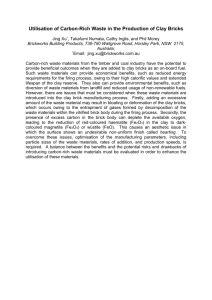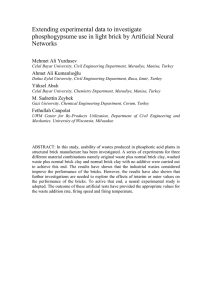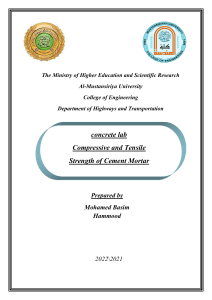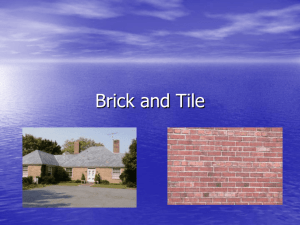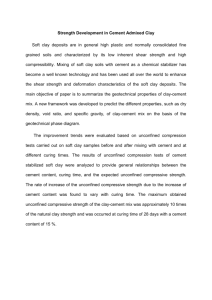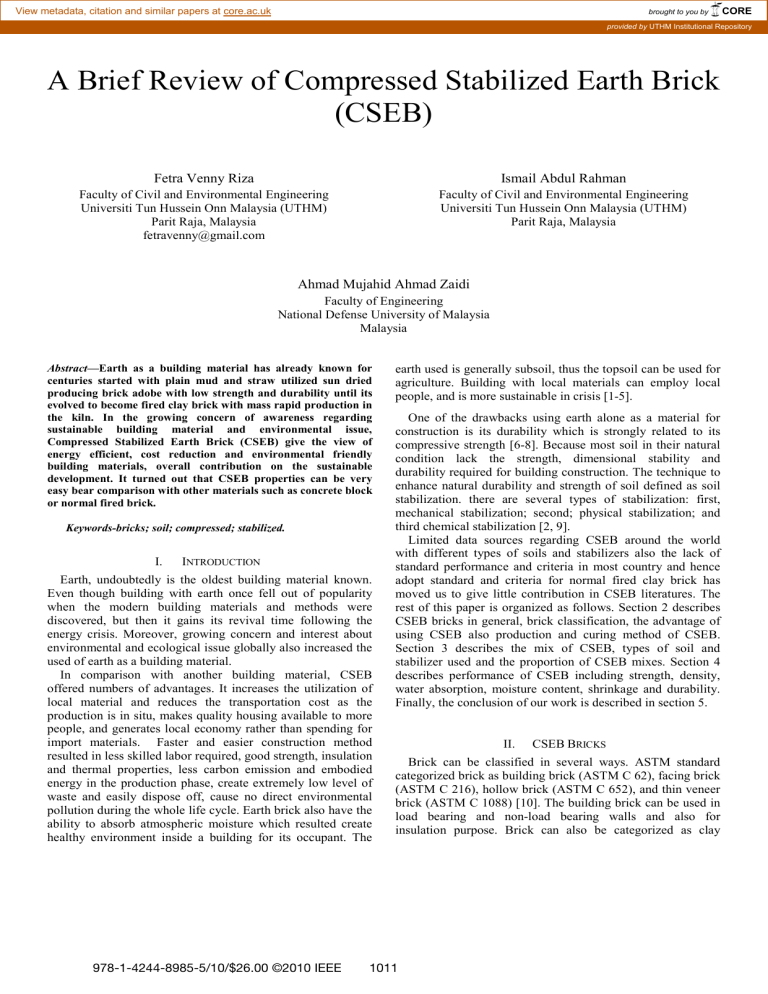
View metadata, citation and similar papers at core.ac.uk brought to you by CORE 2010 International Conference on Science and Social Research (CSSR 2010), December 5 - 7, 2010, Kuala Lumpur, providedMalaysia by UTHM Institutional Repository A Brief Review of Compressed Stabilized Earth Brick (CSEB) Fetra Venny Riza Ismail Abdul Rahman Faculty of Civil and Environmental Engineering Universiti Tun Hussein Onn Malaysia (UTHM) Parit Raja, Malaysia fetravenny@gmail.com Faculty of Civil and Environmental Engineering Universiti Tun Hussein Onn Malaysia (UTHM) Parit Raja, Malaysia Ahmad Mujahid Ahmad Zaidi Faculty of Engineering National Defense University of Malaysia Malaysia Abstract—Earth as a building material has already known for centuries started with plain mud and straw utilized sun dried producing brick adobe with low strength and durability until its evolved to become fired clay brick with mass rapid production in the kiln. In the growing concern of awareness regarding sustainable building material and environmental issue, Compressed Stabilized Earth Brick (CSEB) give the view of energy efficient, cost reduction and environmental friendly building materials, overall contribution on the sustainable development. It turned out that CSEB properties can be very easy bear comparison with other materials such as concrete block or normal fired brick. Keywords-bricks; soil; compressed; stabilized. I. INTRODUCTION Earth, undoubtedly is the oldest building material known. Even though building with earth once fell out of popularity when the modern building materials and methods were discovered, but then it gains its revival time following the energy crisis. Moreover, growing concern and interest about environmental and ecological issue globally also increased the used of earth as a building material. In comparison with another building material, CSEB offered numbers of advantages. It increases the utilization of local material and reduces the transportation cost as the production is in situ, makes quality housing available to more people, and generates local economy rather than spending for import materials. Faster and easier construction method resulted in less skilled labor required, good strength, insulation and thermal properties, less carbon emission and embodied energy in the production phase, create extremely low level of waste and easily dispose off, cause no direct environmental pollution during the whole life cycle. Earth brick also have the ability to absorb atmospheric moisture which resulted create healthy environment inside a building for its occupant. The 978-1-4244-8985-5/10/$26.00 ©2010 IEEE earth used is generally subsoil, thus the topsoil can be used for agriculture. Building with local materials can employ local people, and is more sustainable in crisis [1-5]. One of the drawbacks using earth alone as a material for construction is its durability which is strongly related to its compressive strength [6-8]. Because most soil in their natural condition lack the strength, dimensional stability and durability required for building construction. The technique to enhance natural durability and strength of soil defined as soil stabilization. there are several types of stabilization: first, mechanical stabilization; second; physical stabilization; and third chemical stabilization [2, 9]. Limited data sources regarding CSEB around the world with different types of soils and stabilizers also the lack of standard performance and criteria in most country and hence adopt standard and criteria for normal fired clay brick has moved us to give little contribution in CSEB literatures. The rest of this paper is organized as follows. Section 2 describes CSEB bricks in general, brick classification, the advantage of using CSEB also production and curing method of CSEB. Section 3 describes the mix of CSEB, types of soil and stabilizer used and the proportion of CSEB mixes. Section 4 describes performance of CSEB including strength, density, water absorption, moisture content, shrinkage and durability. Finally, the conclusion of our work is described in section 5. II. CSEB BRICKS Brick can be classified in several ways. ASTM standard categorized brick as building brick (ASTM C 62), facing brick (ASTM C 216), hollow brick (ASTM C 652), and thin veneer brick (ASTM C 1088) [10]. The building brick can be used in load bearing and non-load bearing walls and also for insulation purpose. Brick can also be categorized as clay 1011 bricks, mortar brick, fired or unfired brick and others. CSEB brick is distinguished with conventional fired bricks through its production process. CSEB brick requires compaction whether it’s static, dynamic or vibro-static methods and also the content of stabilizer added for gaining its strength. A striking contrast between CSEB and conventional bricks is the energy consumed during the production process and carbon emission. CSEB brick creates 22 kg CO2/tonne compare to that of concrete blocks (143 kg CO2/tonne), common fired clay bricks (200 kg CO2/tonne) and aerated concrete blocks (280 – 375 kg CO2/tonne) during production [1]. In average, cement stabilised earth bricks consumed less than 10% of the input energy as used to manufacture similar fired clay and concrete masonry unit [2]. Production of CSEB required moderate to low skilled worker since the CSEB manufacture is very simple. It only takes 3 stages process which are: soil preparation, mix compression and the curing. In soil preparation, it needs careful and correct selection of the soil to get the best result and after the mix was put in the mould, it should be given proper compressive load. Curing method in CSEB production usually took advantage from natural humid where bricks could stacked immediately after compression but the strength gain over time and it is important to prevent rapid drying out hence the brick is moist cured under polythene sheet (or wet gunny in India) in the open air (humid atmosphere where air relative humidity >70% is the best condition in order to assure a maximum hydration of the used stabilizer) for about 28 days if used cement as a stabilizer [6, 11-13]. III. MIXES Stabilizer for CSEB playing an important role in creating bonding between soil-stabilizers mixes. One of the main functions of the stabilizing medium is to reduce the swelling properties of the soil through forming a rigid framework with the soil mass, enhancing its strength and durability [14]. Portland cement is the most widely used stabilizer for earth stabilization. Many research works [2, 8, 15] found that soil with plasticity index below 15 is suitable for cement stabilization. Typically, cement binder is added between 4 and 10 % of the soil dry weight [16]. However, if the content of cement is greater than 10% then it becomes uneconomical to produce CSEB brick. For brick using less than 5% of cement, it often too friable for easy handling [2]. For soil that has plasticity index below 15 more suitable to use cement as a stabilizer whether for the soil that has plasticity index above 15 or have clay content, it is suggested to use lime as a stabilizer [8, 17]. Lime can be added to the cement and clay mix to enhance stabilization process because with the additional lime, the lime-clay ratio will be increased due to the existing of lime in cement and the present of lime attributed to the immediate reduction of plasticity [18]. Although the same trend happen to the soil-cement mixes, the immediate effect of modification more obvious in the soillime mixes [17]. When lime added to the clay soil, first it adsorbed by the clay mineral until the affinity of the soil for lime achieved, its call lime fixation and normally the amount between 1 to 3% lime added by weight. The addition of lime after lime fixation contributing to the pozzolanic reaction that created hydrated gel and this process is time dependent where strength developed gradually over long period [19]. When clay soil is blended with Portland cement in the presence of water, hydration reaction will take place. The compound of C3S and C2S present in the Portland cement react with water forming complex Calcium Silicate Hydrates (C-S-H) gel [20]. C-S-H gel has beneficial effect in clay material by reduction of deleterious heaving effects such as the growth of ettringite due to the rapid removal of alumina. The formation of ettringite contributes to the increase of porosity and simultaneously decreases the free moisture content. The C-S-H gel formed fill the void spaces and bind the soil particles together thus imparting strength to the soil mixture [21]. For laterite soil, Attoh-Okine [18] noted that lime stabilization of soil is a function of quantity of lime, curing time, environmental condition and testing method. Billong [9] also observed the potential of using lime and other pozzolanic material to form a binder that can acts as a stabilizer. Oti [2022] suggested the combination of lime with ground granulated blast furnace (product in the manufacturing of pig iron) that will gives better performance compared to the use of cement as the stabilizer. Natural stabilizer as proposed by Mesbah at el [16] is more environmental friendly and cheaper. Even though stabilization with hydraulic binder (cement) significantly improved strength and water resistance but it contributes to negative environmental impact. Guettala et al [6] suggested the use of an aqueous dispersion of resin as an additive in earth stabilizer. The additive has increased the strength significantly until 2-3 fold to those indicated by standards for both wet and dry conditions. In general, soil stabilizations enhance quite significant bricks properties as described in section 4. Types of soil played an important role to determine the proper stabilizer for specific properties of brick to be enhanced. Even though the best soil for stabilization is the soil that has low plasticity, the advantages of using cement for soil with low plasticity can be substituted with lime and other pozzolanic based stabilizer for soil with high plasticity and high clay content. The inventions of new stabilizers whether it from natural or artificial substances have had broaden the range of options to be chosen from. IV. PERFORMANCE OF CSEB A. Strength Apparently, compressive strength is the most universally accepted value for determining the quality of bricks. Nevertheless, it intensely related with the soil types and stabilizer content. Typically, determination of compressive strength in wet condition will gives the weakest strength value. Reduction in compressive strength under saturation condition can be attributed to the development of pore water pressures and the liquefaction of unstabilized clay minerals in 1012 the brick matrix. Factors affecting the CSEB brick strength are cement-content, types of soil (plasticity index), compaction pressure and types of compaction. Optimum cement content for the stabilization is in the range of 5% to 10% where addition above 10% will affect the strength of the bricks in negative way. Plasticity index of the clay soil is usually in the range of 15 to 25. The best earth soils for stabilization are those with low plasticity index. But for plasticity index >20, it is not suitable with manual compaction [2]. Anifowose [14] found that iron presents in the soil is responsible for low compressive strength in the soil stabilization process. Table 1 provides the summary of salient research literatures related to the compressed earth brick comprises prominent study that ranging from 1995 to 2009. Table 1 Overview of salient research literatures pertaining to the properties of CSEB Research Work Walker, P.J., 1995 “Strength, durability and shrinkage characteristics of cement stabilised soil blocks” [4] Stabilizer OPC Types of soil Clay soil Method -Manual compaction -compaction pressure 2-4 MN/mm2 -Dimension 295 x 140 x 130 mm -BSI 6073 (drying shrinkage) -AS 2733 -ASTM D559 (resistance to water erosion) -Manual/constant volume pressure. -Compaction pressure 2 MN/mm -Dimension 295 x 140 x 125 mm2 -AS 2701 (wet mixing) -AS 1289 (optimum moisture content) -AS 2733 (compressive strength, drying shrinkage, initial rate of absorption) -ASTM D 559 (durability) -ASTM D 558 (optimum moisture content) -ASTM C 140 (dry density, total water absorption)) -ASTM D 559 (durability) -ASTM C 110 (water retention) -ASTM C 1027 (bond wrench testing) -ASTM D 559-57 (durability) -ASTM D 560 (freeze-thaw test) Findings -Dry density -Dry/saturated compressive strength -Modulus of rupture -Drying shrinkage -Resistance to water erosion Remarks Propose empirical relationship that modulus of rupture shall equal at least one-sixth of compressive strength as a simple mean of field assessment. Walker and Stace, 1996 “Properties of some cement stabilised compressed earth blocks and mortars”[23] OPC Clay soil -Compressive strength -Drying Shrinkage -Durability -Water absorption Soil with mineral content less than 15% to 30% most suitable with cement stabilization between 5% and 10%. Walker, P.J., 1999 “Bond characteristics of earth block masonry”[24] OPC Kaolinite clay soil -Flexural bond strength Bond strength clearly limited by block strength and characteristic flexural bond strength between pressed earth blocks and mortars (soil:cement or cemen:lime:sand) is often < 0.1 MPa. Guettala et al, 2002 “Durability of lime stabilized earth blocks[11]” Lime Clay soil, sand -Compressive strength -Water absorption -Durability - Clay sandy soil -Static compaction -Vibro-static compaction -Dynamic compaction Sandy silty soil -Dimension 295 x 140 x 100 mm -Direct tensile test method -Splitting tensile strength -Compressive strength -Shrinkage -Water permeability -Conductivity -Durability -Tensile strength -Compressive strength increase with increasing of compacting stress. -Water absorption and weight loss decrease with increasing of compacting stress and lime content. -Mechanical stabilization by dynamic compaction is better than static or vibro-static compaction. -Chemical stabilization with cement content higher than 8% resulted better compressive strength. The used of natural fiber reinforcement can improve ductility in tension, inhibition of tensile crack propagation after initial formation, and inhibition of shrinkage cracking. -Uniaxial compression testing of earth blocks should be undertaken on individual unit. -For predictive purpose, unconfined compressive strength should be taken as 5x bending strength. -Flexural/bending [4]test provides a simple alternative method to compression testing as a means of assessing quality in situ. Bahar et al, 2004 “Performance of compacted cement-stabilised soil”[25] OPC Mesbah et al, 2004 Sisal fibers “Development of a direct tensile test for compacted earth blocks”[20] Walker, P.J., 2004 “Strength and erosion characteristics of earth block and earth block masonry”[26] Guettala et al, 2005 “Durability study of stabilised earth concrete under both laboratory and climatic conditions exposure”[27] Morel et al, 2005 Oti et al, 2009 “Engineering properties of unfired clay masonry bricks”[15] Oti et al, 2009 “Design thermal values for unfired clay bricks”[29] Jayasinghe, C. and Mallawaarachchi, R.S., 2009 “Flexural strength of compressed stabilized earth masonry materials”[30] Oti et al, 2009 “Compressive strength and microstructural analysis of unfired clay masonry bricks”[19] -Block compressive strength -Block modulus of rupture -Prism compressive strength -Durability OPC, lime, Medalatex resin Sandy clayey soil OPC soil Calcined kaolinitic clay, industrial slaked lime Quicklime, hydraulic lime, GGBS, OPC Laterite soil -Hydraulic press -Force applied 10 kN -Pressed surface 115.4 x 80 mm -Pozzolanic properties -Compressive strength -Water absorption -Density Lower Oxford Clay (LOC) -BS 1924-2 (1990) (max dry density, optimum moisture content) -Compressive strength -Water absorption -Moisture content -Density Quicklime, hydraulic lime, GGBS, OPC Lower Oxford Clay (LOC) -Design values for thermal conductivity and thermal resistance OPC Laterite soil -BS EN-772-1 (compressive strength) -DDCEN/TS 772-22 (Freeze/thaw cycle) -BS EN 771-2 (water absorption) -BS EN 1745 (moisture content, dry density, thermal conductivity, thermal resistance) -ASTM C518-91 (thermal value) -ASTM C1132-89 (thermal value) -Dimension *brick 230 x 110 x 75 mm *block 225 c 225 x 115 mm -BS 5629: Part 1: 1992 (testing procedure) Quicklime, hydraulic lime, GGBS, OPC Lower Oxford Clay (LOC) “Compressive strength testing of compressed earth blocks”[28] Billong et al, 2008 “Properties of compressed lateritic soil stabilized with a burnt clay-lime binder: Effect of mixture components”[21] -Manual compressed -Static pressure 2 MPa -Dimension * 295 x 140 x 120 * 295 x 140 x 90 * 295 x 140 x 80 * 295 x 140 x 45 -ASTM 1984 (compr strength) -ASTM 1987 (modulus of rupture) -ASTM D 559 (1989) (durability-wetting and drying) -BSI 1985 (compr strength) -AS 1997 (compr strength) -AS 2002 (modulus of rupture, water spray test) -Weisz at al 1995 (water-drip test) -Manual static compression -Pressure applied 15 MPa -Dimension 100 x 100 x 200 mm -ASTM D 559 (durability) -ASTM D 560 (freez and thaw test) -Doat et al (spray test) -Dimension * UK 215 x 102.5 x 65 mm * AS 230 x 110 x 76 mm -Compressive strength testing *Direct unit strength *RILEM test *Indirect test -BS 1924-2:1990 (compr strength) -BS EN 771-1:2003 (compr strength) -SEM, SBD/EDX (microstructure) 1013 -Compressive strength -Absorption -Durability -Density -Compressive strength -Moisture content -Flexural strength (three-point bending test) -Durability improves considerably with the addition of stabilizers -For sandy clayey soil, it is recommended to stabilize with 5% cement and compacting stress at 10 MPa -Most recommended test for compressive strength is direct, confined test on single unit -RILEM test dependent on mortar quality since blocks are tested together with a mortar joint in a prism -Indirect testing (three-point bending test) can provide an indication of relative strength -Increase the percentage of lime increases compressive strength -increase laterite-binder ratio decrease compressive strength and water absorption but increase apparent density -Quicklime removes water from the stabilised mix -Hydraulic lime has slower setting time and gain strength over time -It is possible to utilize Lime-GGBS binder, with or without dosing with small amount of PC Material density and moisture content are the fundamental parameters for thermal conductivity -Flexural strength parallel/perpendicular to bed joints of brick panel, block panel and rammed earth, Flexural strength of brick or block panel about 0.25N/mm2 and comparable with burnt clay bricks having water absorption above 12% -Compressive strength -Swelling/shrinkage -SEM -Compressive strength result showed bricks made of industrial by-product are strong and volumetrically stable -Effect of swelling/shrinkage on the unfired clay bricks is negligible, suggesting good durability The strength of the CSEB can be increased by adding natural fibers where it can improve the ductility in tension. The improvement is by retarding the tensile crack propagation after initial formation and also the shrinkage cracking [16]. Since there is no standard testing for CSEB, most researchers determined the compressive strength using the testing method used for fired clay brick and concrete masonry block such as ASTM 1984, BS 6073-1:1981, BSI 1985, BS EN 772-1, BS 1924-2:1990, Standard Australia 1997, Australian Standard 2733 [2, 12, 21, 22]. The unconfined compressive test needs expensive equipment and must be carried out in the laboratory, hence some researchers suggest using indirect compressive test (i.e. flexural test/modulus of rupture/three-point bending test). These indirect test provide simple, inexpensive and fast assessment of in-situ bending strength of the brick [23, 24]. Walker [2, 12] suggested to use factors that modulus of rupture is equivalent with one-sixth of its compressive strength and in his latest experiment suggested that unconfined compressive strength is about five times of the bending strength. Compacting procedure also affect considerably on the compressive strength of the CSEB brick. Guettala et al [8] concluded that by increasing the compacting stress from 5 to 20 MPa, it will improve the compressive strength up to 70%. His conclusion was strengthened by Bahar et al [25] observed that by using dynamic compaction energy dry compressive strength increases by more than 50% but for vibro-static compaction increases slightly for about 5%. Brick strength and brick characteristic flexural bond strength are the factors that limiting the bond strength between bricks and mortars in wall panels made from CSEB [26]. Hence, types of bricks such as solid, interlocking or hollow and type of bond like English, Flemmish or Rat trap bond also play an important role in flexural strength of the panels [27]. B. Density Commonly, most researchers found that the density of compressed stabilized earth bricks is within the range of 1500 to 2000 kg /m3. Density of the compressed earth brick is consistently related to its compressive strength and compactive force applied during production. The dry density is largely a function of the constituent material’s characteristics, moisture content during pressing and the degree of compactive load applied and even in India compressive strength is controlled by density. Types of compaction applied such as dynamic, static and vibro will also affect the density. The density of brick can be determined through standard procedure such as ASTM C 140 and BS 1924-2 (1990) and others [20, 22, 23, 25, 26]. C. Water Absorption and Moisture Content Water absorption is a function of clay and cement content and usually related with the strength and durability of earth bricks and therefore it is important to determine the rate of water absorption of earth bricks. Oti [20] stated that water absorption rate decrease with increasing in age of earth bricks. High rate of water absorption of a specimen may cause swelling of stabilized clay fraction and resulting in losing strength with time. As observed by Walker [15] water absorption, as well as porosity, increases with clay content and decreasing cement content. Between cement, lime, cement-lime and cement-resin, combination cement and resin stabilization show the lowest water absorption both in capillary absorption and total absorption [6]. Freidin and Errel [11] tried to reduce the water uptake by adding a hydrophobic material, in this case was siloxane-polymethylhydrohen-siloxane and combined with slag + fly ash which is highly absorbent and the result showed that the water uptake with the addition of 0.5% siloxane less than a quarter of the water uptake of fly ash-slag without additive. Sand content in the mixes apparently can reduce water absorption and weight loss even though does not affect the compressive strength significantly [8]. Standard used to determine water absorption is ASTM C 140 (total water absorption), BS EN 771-2 and Australian Standards 2733 (initial rate of absorption) [15, 22, 26]. Moisture contents affect strength development and durability of the material and have a significant influence on the long term performance of stabilized soil material especially has an effect on bonding with mortars at the time of construction. When the brick is dry, water is rapidly sucked out of the mortar preventing good adhesion and proper hydration of the cement and when the brick is very wet the mortars tends to float on the surface without gaining proper adhesion [20, 26]. Types of compaction affect the optimum water content in the stabilized mixes. Dynamic compaction can reduce the optimum water content from 12% to 10% with the compressive strength increased for about 50%. Bahar [25] stated the optimum water content range between 10 to 13% for static compaction, as for vibro-static compaction slightly increase compressive strength with the same water content for low compressive load. According to Osula [17] soil-lime mixes required higher optimum moisture content than soilcement mixes. Standards conform to determine water content such as ASTM D 558, Australian Standards 1289, BS 1924-2 (1990), BS EN 1745[15, 20, 22, 26]. D. Shrinkage Drying shrinkage of the bricks was primarily governed by the plasticity index and cement content. Water-loss also contributes to the shrink of the clay fraction. For low clay mineral content (index plasticity below 20%), drying shrinkage showed steady increase with the increase of clay content, but for plasticity index beyond 25% – 30% drying shrinkage increased rapidly as the clay content also increased. Soil with plasticity index <20 is good for cement stabilization with cement content 10%. And commonly used drying shrinkage limit from 0.008% to 0.10% [2, 15, 26]. Sand as part of the mix, seems has significance influence in shrinkage although sand content does not affect significantly 1014 the compressive strength as stated by Guettala [8] but Rahman [28] found out it can decrease plasticity, linear shrinkage and warping. Bahar et al [25] reported that shrinkage increases rapidly during the first 4 days for cement stabilized earth bricks and the addition of sand reduces the shrinkage as sand particles oppose the shrinkage movement. He also observed that the addition of cement content can reduce the shrinkage until 44% for 10% cement content added. BSI 6073 and Australian Standards 2733 can be used to measure the drying shrinkage [2, 15]. E. Durability The basic principal of the stabilization is to prevent water attacks and it could be achieved if a durable material can be obtained with limited loss in mechanical strength in a wet state. From several experiments, durability associated with the stabilizer content, clay content and compacting stress. Basically, durable stabilized clay material building can be achieved as long as they are not saturated. The problems arise when the materials are subjected to the long term saturation and exposed to various climatic conditions. Also it is observed that the present of unstabilized material was likely to be particularly detrimental to the durability. Heathcote [7] observed that rain drop can release the kinetic energy that impacted the brick and causing material falling from the surface of wall panels. He stated that wet/oven dry ratio of 33% may be a suitable criterion for evaluating the durability of cement stabilized earth specimen. As observed by Oti [20] combination bricks made of clay, cement, lime and Ground Granulated Blast Furnace (GGBS) subjected up to 100 cycles 24 hours repeated of freezing and thawing showed satisfaction result where only having maximum 1.9% weight loss at the end of the 100th cycles. The examination after the test showed no damaged occur of any type. The measurement of durability according to the standards such as ASTM normalization (ASTAM 1993), ASTM D 59957 (resistance to water erosion), ASTM 560 and DDCENT/TS 772-22 (freeze-thaw test), wire brush test, Australian Standards 2002 and Doat et al (water spray test), Weisz et al (water drip test), are very severe compared to the natural condition, nevertheless, in general, clay material still have potential to damage from rising damp, freeze/thaw cycles and surface erosion caused by wind-driven rain as clay mineral tend to disrupt the cement action [2, 8, 12, 15, 20, 22, 26]. F. Thermal Value In the growing concern of energy conscious and ecological awareness, thermal comfort in building materials is an important aspect that attracts great attention nowadays since building regulations nowadays stressing more on the thermal performance of the buildings compare to the past. As a building material, brick has quite excellent thermal conductivity. Oti [22] observed that thermal conductivity is a function of the material density and moisture content Thus design value for thermal conductivity can be determined through experimental and theoretical method. Compressed stabilized earth bricks showed better thermal conductivity value compare to the fired clay bricks. ¾ Lime-GGBS based: 0.2545 ± 0.0350 W m-1 K-1 ¾ Cement-GGBS based: 0.2612 ± 0.0350 W m-1 K-1 ¾ Fired clay bricks: 0.4007 ± 0.0350 W m-1 K-1 Bahar et al [25] noted that the addition of cement and sand content can decrease slightly the conductivity of the brick. The advantage of having low thermal conductivity can result in energy efficiency, cost reduction of heating in winter and air conditioning in summer, and environmental friendly of a building. Fired clay bricks have higher conductivity value because the firing process of clay bricks makes the clay to partially combine to form a glassy product so as to give the product the strength and durability. It is also a result from the breakdown of the original clay mineral and the formation of new crystalline material and glass phases. To determine the thermal value of compressed stabilized earth bricks can utilize the following standards such as BS EN 1745 (thermal conductivity and thermal resistance), ASTM C 518-91 and ASTM C 1132-89 (thermal value) [22]. V. CONLUSION In this paper, we have done a brief review on Compressed Stabilized Earth Brick (CSEB). Previous researches showed that compressed earth bricks demonstrate many advantages compare to conventional fired bricks. Compressed stabilized earth bricks are ultimately greener, eco friendly, comparable in strength, durability and thermal conductivity. The use of compressive earth bricks also promotes healthier living for the building dwellers. Still it has many possibilities to explore more in enhancing its properties. Data from related works showed that an average saturated compressive strength of CSEB is 35% less than its average dry compressive strength. The average density of CSEB is almost equivalent with the common brick. Also it has shown that compressed earth brick demonstrates comparable durability with that of normal fired clay bricks. Thermal value experiment indicated that thermal conductivity of CSEB showed compliance with the design thermal requirements for clay masonry and building regulations. The research conducted emphasizes on the advantages of using CSEB for better living. As it promote healthier building material and cost reducing not only in production but also in service cost. Although economic potential may attract more rather than ecological reasons, the full scale production of compressed stabilized earth bricks has demonstrated that this kind of building material have a great potential in the future for low to medium cost housing construction and contribute on sustainable development. 1015 ACKNOWLEDGMENT The authors would like to thank the Universiti Tun Hussein Onn (UTHM), Johor, Malaysia for providing the international student scholarship and finally acknowledge the research and staffing resources provided by the Faculty of Civil and Environment of the Universiti Tun Hussein Onn (UTHM). REFERENCES [1] [2] [3] [4] [5] [6] [7] [8] [9] [10] [11] [12] [13] [14] [15] [16] [17] [18] [19] [20] [21] T. Morton, “Earth Masonry Design and Construction Guidelines”, Berkshire: Construction Research Communications Limited, 2008 P.J. Walker, “Strength, durability and shrinkage characteristics of cement stabilised soil blocks”, Cement and Concrete Composites, 17(4): p. 301-310, 1995 B.V. Venkatarama Reddy, and K.S. Jagadish, “Embodied energy of common and alternative building materials and technologies”, Energy and Buildings, 35(2): p. 129-137, 2003 B.V. Venkatarama Reddy, and P. Prasanna Kumar, “Embodied energy in cement stabilised rammed earth walls”, Energy and Buildings, 42(3): p. 380-385, 2009 J.C. Morel, et al., “Building houses with local material: means to drastically reduce the environmental impact of construction”, Building and Environment, 36: p. 1119-1126, 2001 A. Guettala, A. Abibsi, and H. Houari, “Durability study of stabilized earth concrete under both laboratory and climatic conditions exposure”, Construction and Building Materials, 20(3): p. 119-127, 2006 K.A. Heathcote, “Durability of earthwall buildings”, Construction and Building Materials, 9(3): p. 185-189, 1995 A. Guettala, H. Houari, B. Mezghiche, R. Chebili, “Durability of lime stabilized earth blocks”. Courrier du Savoir, 02: p. 61-66, 2002 N. Billong, U.C. Melo, F. Louvet, D. Njopwouo, “Properties of compressed lateritic soil stabilized with a burnt clay-lime binder: Effect of mixture components”. Construction and Building Materials, 23(6): p. 2457-2460, 2008 R.C. Jaffe, “Masonry Instant Answer”, New York: The McGraw-Hill Companies, Inc, 2004 K. Freidin and E. Erell, “Bricks made of coal fly-ash and slag, cured in the open air”. Cement and Concrete Composites, 17(4): p. 289-300, 1995 P.J. Walker, “Strength and Erosion Characteristics of Earth Blocks and Earth Block Masonry”, Journal of Materials in Civil Engineering,. 16(5): p. 497-506, 2004 CRAterre, “The Basic of Compressed Earth Blocks”, Eschborn, Germany: Deutsches Centrum fur Entwicklungstechnologien, 1991 A.Y.B. Anifowose, “Stabilisation of lateritic soils as a raw material for building blocks”, Buletin of Engineering Geology and the Environment, 58: p. 151-157, 2000 P.J. Walker and T. Stace, “Properties of some cement stabilised compressed earth blocks and mortars”, Materials and Structures/Mat4riaux et Constructions, 1996. 30: p. 545-551, November 1997 A. Mesbah, J.C. Morel, P. Walker, K. Ghavami, “Development of a Direct Tensile Test for Compacted Earth Blocks Reinforced with Natural Fibers”, Journal of Materials in Civil Engineering, 16(1): p. 9598, 2004 D.O.A. Osula, “A comparative evaluation of cement and lime modification of laterit”, Engineering Geology, 42(1): p. 71-81, 1996 N.O. Attoh-Okine, “Lime treatment of laterite soils and gravels – revisited”, Construction and Building Materials, 9(5): p. 283-287, 1995 F.G. Bell, “Lime stabilization of clay minerals and soils”, Engineering Geology, 42(4): p. 223-237, 1996 J.E. Oti, J.M. Kinuthia, and J. Bai, “Engineering properties of unfired clay masonry bricks”, Engineering Geology, 107(3-4): p. 130-139, 2009 J.E. Oti, J.M. Kinuthia, and J. Bai, “Compressive strength and microstructural analysis of unfired clay masonry bricks”, Engineering Geology, 109(3-4): p. 230-240, 2009 [22] J.E. Oti, J.M. Kinuthia, and J. Bai, “Design thermal values for unfired clay bricks”, Materials & Design, 31(1): p. 104-112, 2009 [23] J.C. Morel, A. Pkla, and P. Walker, “Compressive strength testing of compressed earth blocks”, Construction and Building Materials, 21(2): p. 303-309, 2005 [24] J.C. Morel, and A. Pkla, “A model to measure compressive strength of compressed earth blocks with the 3 points bending test”. Construction and Building Materials, 16(5): p. 303-310, 2002 [25] R. Bahar, M. Benazzoug, and S. Kenai, “Performance of compacted cement-stabilised soil”, Cement and Concrete Composites, 26(7): p. 811-820, 2004 [26] P.J. Walker, “Bond Characteristic of Earth Block Masonry”, Journal of Materials in Civil Engineering, 11(3): p. 249-256, 1999 [27] C. Jayasinghe, and R.S. Mallawaarachchi, “Flexural strength of compressed stabilized earth masonry materials”, Materials & Design, 30(9): p. 3859-3868, 2009 [28] M.A. Rahman, “Properties of clay-sand-rice husk ash mixed bricks:, International Journal of Cement Composites and Lightweight Concrete, 9(2): p. 105-108, 1987 1016
